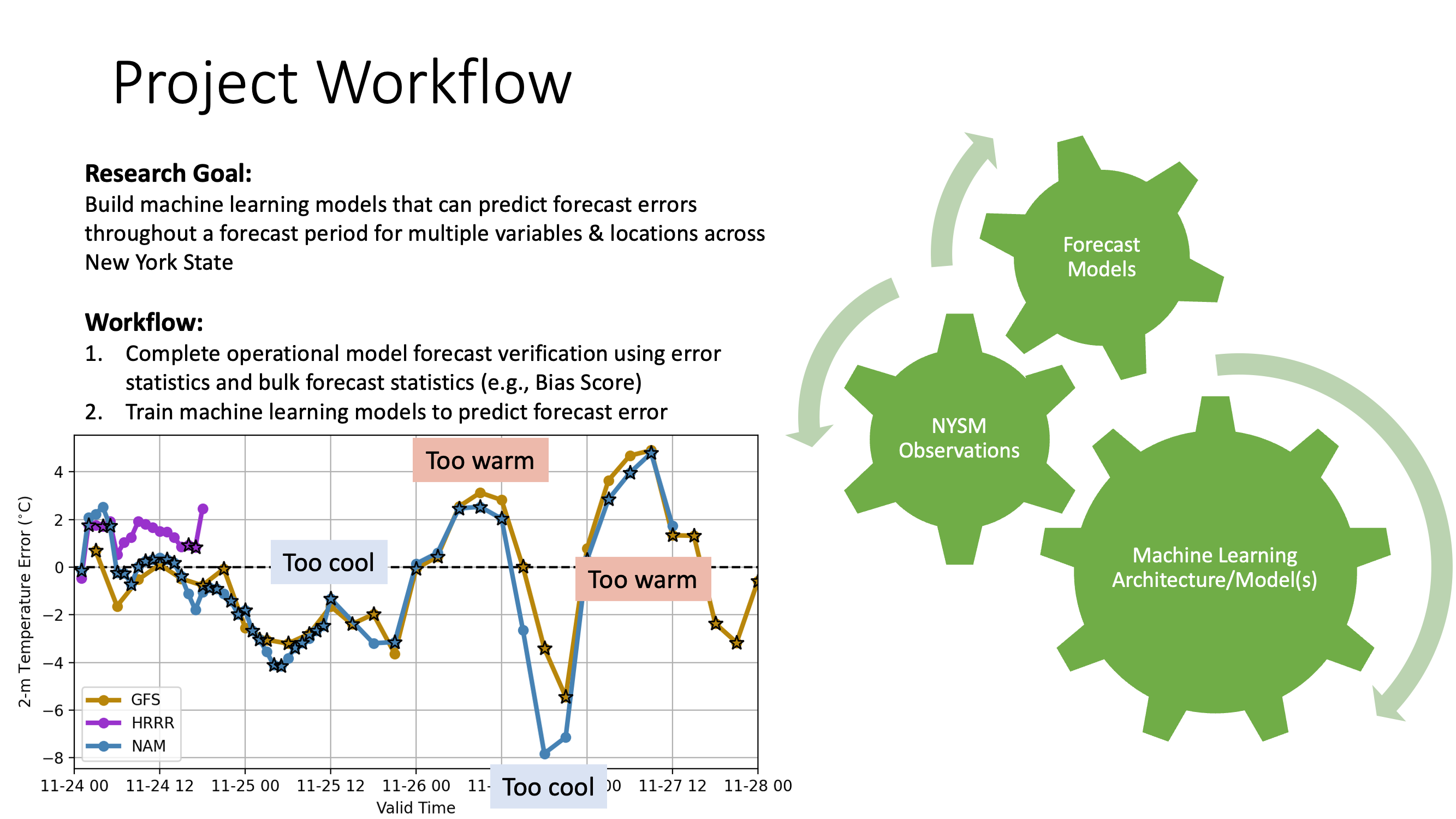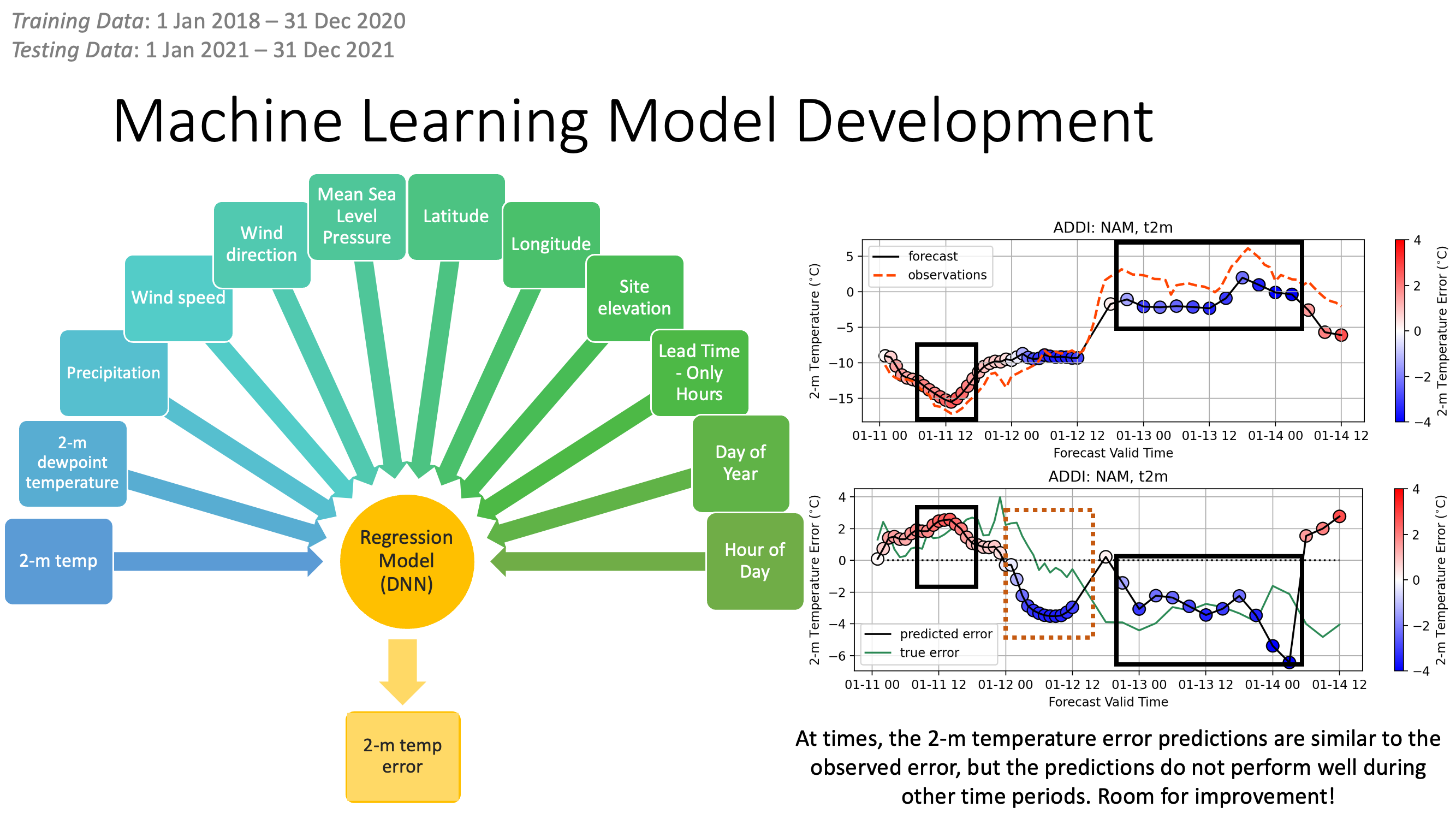Research Interests
The bulk of my recent research endeavors have been focused on understanding high-intensity precipitation forecast sensitivity to the representation of microphysics within numerical weather prediction models, namely the Weather Research and Forecasting (WRF) model. Through this research, I have developed expertise in the process-level development of forecast uncertainty and its resultant impact on both liquid and frozen precipitation. Futhermore, I am thrilled to continue working within the forecast uncertainty space by applying machine learning methods through my Postdoctoral position within the Winter Weather Group of the NSF AI Institute for Research on Trustworthy AI in Weather, Climate, and Coastal Oceanography (AI2ES).
Postdoctoral Research
Winter conditions across New York State include frequent mesoscale snow squalls from Lakes Erie and Ontario, synoptic-scale winter cyclones, and large-scale, high-impact Nor’easters. Understanding and quantifying the associated forecast uncertainty has presented a great challenge within the Atmospheric Science modeling and forecasting community. Numerical forecast models such as the GFS, NAM, and HRRR each have their own uncertainties and biases that can vary depending on (1) the variable of interest (e.g., 2-m temperature, 10-m winds, quantitative precipitation forecast, etc.), (2) the forecast lead time, and (3) the forecast region. The availability of these forecast data coupled with the >1 billion archived observations from the New York State (NYS) Mesonet, including observations from the 126 standard and 54 additional sites providing atmospheric, snow, flux, and soil data over the last 5–6 years, lends to a large-scale statistical verification of the GFS, NAM, and HRRR across NYS.

Upon completion, a database of verification statistics will exist for each forecast model. Machine learning (ML) models will be developed by means of each forecast model’s verification statistics to identify and quantify forecast uncertainty at multiple forecast model initializations and lead times for various winter weather events.

Oral Presentations
Gaudet, L. C. and K. J. Sulia, 2022: The Quantification of Winter-Season Forecast Uncertainty across New York State. 21st Conference on Artificial Intelligence for Environmental Science, Virtual due to COVID-19, Amer. Meteor. Soc.
Dissertation Research
Identifying the Microphysical Sensitivities of Mesoscale and Synoptic Precipitation Using an Ensemble Framework
Advised by Dr. Kara Sulia
Through ensemble sensitivity analysis, this dissertation aims to identify the amount and type of forecast uncertainty that stems from the representation of mixed-phase cloud microphysics in the Weather Research and Forecasting Model (WRF). The first research thrust focuses on the influence of ice crystal shape and choice of ice nucleation parameterization in the Adaptive Habit Microphysics Model (AHM) on the lake-effect storm observed during Intensive Operating Period 4 (IOP4) of the Ontario Winter Lake Effect Systems (OWLeS) Field Campaign. This localized snowstorm provided a natural laboratory to investigate the ice-liquid partitioning within the cloud and various microphysical process rates, as well as the accumulated precipitation magnitude and its associated spatial distribution. Two nucleation parameterizations were implemented, and aerosol data from a size-resolved Advanced Particle Microphysics model were ingested into the AHM for use in parameterizing ice and cloud condensation nuclei. Simulations allowing nonspherical ice growth produced 1.6–2.3% greater precipitation while altering the nucleation parameterization changed the precipitation type.
The second research thrust identifies which microphysics processes led to the greatest forecast uncertainty in the aforementioned lake-effect storm, as these processes have cascading impacts on cloud properties and precipitation. 24 simulations differing in microphysics scheme and/or involving changes to the representation of aerosol and potential ice nuclei concentrations, ice nucleation parameterizations, rain and ice fall speeds, spectral indices, ice habit assumptions, and the number of moments used for modeling ice-phase hydrometeors in each adaptive habit model compose the ensemble analyzed herein. Each of these changes led to varied precipitation types at the surface; 15 members forecast a mixture of snow, ice, and graupel, seven members forecast snow and ice, and the remaining two members forecast a combination of snow, ice, graupel, and rain. Analysis of observations spanning more than a point location, such as polarimetric radar observations and aircraft measurements, and comparisons to the ensemble provided insight into cloud composition and processes that led to the forecast differences. Ensemble spread was controlled by hydrometeor type differences spurred by processes or parameters (e.g., ice fall speed) affecting graupel mass.
The ensemble approach develops further in the third research thrust, in which a stochastic perturbed parameterization (SPP) was implemented into WRF and the AHM to investigate the impact of microphysics process rate perturbations on high-intensity precipitation affecting New York State (NYS). This SPP methodology was used to investigate perturbations to the most active process rates in a synoptic rainstorm and two lake-effect storms, including OWLeS IOP4. Nine tuning experiments with different spatial, temporal, and amplitude autocorrelation parameters were conducted to identify those most conducive to physically-sound ensemble spread. Along with random number seeds, these parameters were used to generate stochastic patterns that perturbed a specified process, thereby producing an ensemble including stochastic microphysics uncertainty. These SPP methods were compared to ensembles involving initial and boundary condition (IC/BC) uncertainty, the Stochastic Perturbed Physics Tendency (SPPT), independent SPPT (iSPPT) perturbation methods, and IC/BC ensembles combined with SPPT, iSPPT, and/or SPP. Perturbations affected the quantitative precipitation forecast (QPF) across NYS, with the greatest changes in spread in the upper-end of the QPF range. Unanticipated relationships among processes were spurred by perturbations and examined in low- and high-end QPF regions. Perturbations to ice deposition were found to affect the QPF differently than other processes. In sum, this dissertation contributes new knowledge about precipitation responses to the representation of microphysics and associated forecast uncertainty in WRF.
Peer-Reviewed Publications (2)
Gaudet, L. C., K. J. Sulia, T. C. Tsai, J. P. Chen, and J. P. Blair, 2021: A Microphysical Ensemble Based Investigation of Lake-Effect Cloud Processes during OWLeS IOP4. J. Atmos. Sci., 78, 1607–1628, https://doi.org/10.1175/JAS-D-20-0045.1.
Gaudet, L. C., K. J. Sulia, F. Yu, and G. Luo, 2019: Sensitivity of Lake-Effect Cloud Microphysical Processes to Ice Crystal Habit and Nucleation during OWLeS IOP4. J. Atmos. Sci., 76, 3411-3434, https://doi.org/10.1175/JAS-D-19-0004.1.
Publications Under Review (2)
Gaudet, L. C., K. J. Sulia, K. M. Lupo, and R. D. Torn, Submitted: Assessing the Impact of Stochastic Perturbations to Microphysics Processes in an Adaptive Habit Model on an Ensemble Forecast. Wea. Forecasting.
Henny, L., L. C. Gaudet, K. M. Lupo, K. Goods, S. Sanders, and Y. Zhang, Under Review: Graduate Student Cohort Experience during an International and Interdisciplinary Research Project. Bull. Amer. Meteor. Soc.
Oral Presentations
Gaudet, L. C. and K. J. Sulia, 2021: Exploring the Applications of New York State Mesonet Data for Ensemble Verification: A Case Study of a Heavy Rain Event. Ninth Symposium on the Weather, Water, and Climate Enterprise, Virtual due to COVID-19, Amer. Meteor. Soc.
Gaudet, L. C. and K. J. Sulia, 2020: Assessing the Robustness of Microphysical Process Representation in an Adaptive Habit Model by Means of Stochastic Parameterizations. 30th Conference on Weather Analysis and Forecasting/26th Conference on Numerical Weather Prediction, Boston, MA, Amer. Meteor. Soc.
Gaudet, L. C. and K. Sulia, 2019: Sensitivity of Lake-Effect Cloud Microphysical Processes to Ice Crystal Habit and Nucleation during OWLeS IOP4. 11th Symposium on Aerosol-Cloud-Climate Interactions, Phoenix, AZ, Amer. Meteor. Soc.
Undergraduate Research
In the summer of 2014, I participated in a research experience at Hobart and William Smith Colleges in Geneva, New York. Under the advisement of Dr. Neil Laird and in collaboration with another student, Coltin Grasmick, I classified lake-effect clouds from satellite imagery over the North American Great Lakes. This work finished a lake-effect cloud climatology that was then used to identify lake-effect clouds with a multi-lake connection involving Lake Ontario to identify environmental conditions that supported such development. The resultant preciptation from those lake-to-lake clouds was explored and contrasted to lake-effect precipitation originating over only Lake Ontario.
Publications (2)
Lang, C. E., J. M. McDonald, L. Gaudet, D. Doeblin, E. A. Jones, and N. F. Laird, 2018: The Influence of the Lake-to-Lake Connection from Lake Huron on the Lake-effect Snowfall in the vicinity of Lake Ontario. J. Appl. Meteor. Climatol., 57, 1423-1439, https://doi.org/10.1175/JAMC-D-17-0225.1.
Laird, N. F., N. D. Metz, L. Gaudet, C. Grasmick, L. Higgins, C. Loeser, and D. Zelinsky, 2017: Climatology of Cold Season Lake-effect Cloud Bands for the North American Great Lakes. Int. J. of Climatology, 37, 2111–2121, https://doi.org/10.1002/joc.4838.